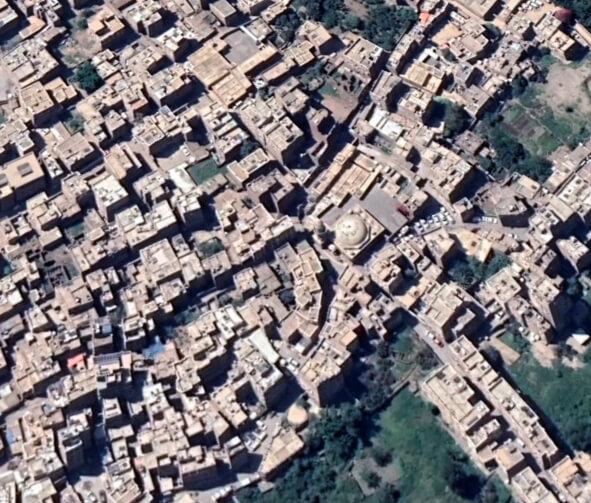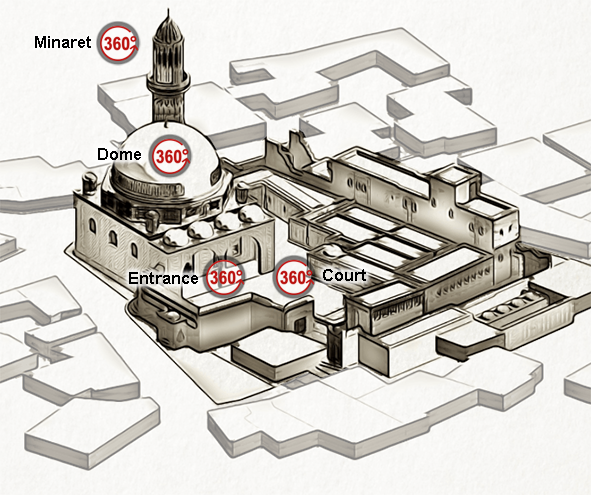
Ṭalḥah Dome – Old Ṣan‘ā’
قبة طلحة- صنعاء القديم ة
Monument description
The building is one of the historical mosques in Old city of Sana’a. It is located in the middle of Talha neighborhood, where it is bounded from the south by the road that runs from Al-Kharaz and Al- Tawoos, and from the north by the road that runs from Al-Weshaly and Jamal Al-Deen to the direction of Dawood and the cow market. The mosque is located north of Moath Mosque and east of the Jamal Al-Deen Mosque. A mosque for the five obligatory prayers, and a home for students seeks knowledge; currently is just used as a mosque for performing the obligatory prayers.

Architectural and cultural value
Construction style and built date: The layout of the Talha dome belongs to the Islamic architecture in the Ottoman era and goes back to the first style of Bursa in Turkey, which is characterized by covering the Prayer Hall with a high dome. The mosque was small in size, and the date of its construction was unknown; the first to extend it and build the Minaret was the minister Muhammad Pasha in 1029 AH / 1619 CE. Then the Mosque was renovated in 1247 AH / 1831 CE by the Imam Al-Mahdi Abdullah son of the Imam Al-Mutawakkil Ahmed son of the Imam Al-Mansur Ali son of the Imam Al-Mahdi Abbas.
Components of the Mosque: The monument is divided into two main sections, the Prayer Hall, and the courtyard, in addition to some annexes such as the minaret, Matahir (Ablution Units), and rooms.
The area of the Monument with courtyard and annexes is about 1300 m2.
Pictures gallery of the monument

360° pictures of the monument
360° pictures of the monument
- Justifications for intervention:
- 1- Due to threats that the monument faces as the time goes by, as well as its exposure to vibrations due to the flight strikes that occurred in several areas around the old wall of Sana’a, and this led to the exacerbation and expansion of the damage.
2- Preserve the building from being destroyed and stop the expansion of damage.
3- The lack of funds to adopt the implementation of the restoration work for the building.
- Monument conditions and treatment:
- The condition of the building is somewhat good, but in some parts there are many damages that need to be restored, namely:
– Urgent interventions for protection and rescue
– Serious damages:
1. A fracture of the lintel. Treatment: Bracing the wall and replace the collapsed lintel with a new one from the same previous materials.
2. The inscriptions surrounding the dome need restoration before they disappear.
Treatment: Skimming the corroded plaster (Qudad) layer; Executing the plaster layer work and re-doing the inscriptions so that the decorations are re-worked in the same way as the original one.
3. Cracks in the minaret balcony. Treatment: Removing damaged stones of the lower part of the balcony then rebuild theme, using the same building materials if possible during treatment.
– Medium damages:
4. Cracks in the walls of the outbuildings and the courtyard. Treatment: Removal of the damaged parts that have cracks and rebuild it using the same building materials if possible.
5. The protective layer of the wooden ceilings of the four domes above the entrance porch of the house of prayer falls from below and the rest of the ceilings of the outbuildings. Treatment: Execute a cladding layer using plaster mortar (Qadad) for the lower part of the ceilings.
6. Erosion and collapse of the plaster (Qadhad) layer of domes that are above the Matahir (ablution unit), and make theme unusable. Treatment: Rehabilitate the Matahir and develop theme with modern sewage networks.

Countries







